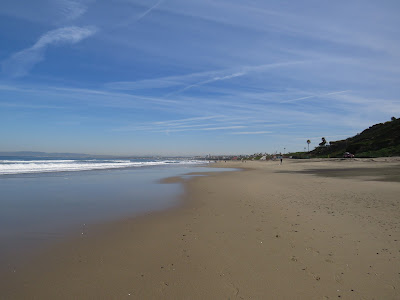Under sunny skies, temperatures in the low 60’s and a slight sea breeze, Caroline and I are hiking along Rat Beach, a short, sandy stretch of shoreline in Torrance, CA. Up ahead, I spot two common shorebirds foraging in the surf zone-a fast-moving Willet with its straight beak and a slow-moving Dowitcher with its curved beak. Nearby, I come upon a pile of Kelp weed lying on the beach. Upon closer look, I notice one of many swarming, 1/4 -inch Kelp flies. The larvae of these flies play a major role in decomposing kelp. Also, both larvae and adult flies are preyed on by beetles and shore birds, serving as an important resource in the sandy beach food web. Looking toward the water, a never-before-seen Heerman’s Gull catches my eye. Named after Adolphus Lewis Heermann, the 19th century explorer and naturalist, this medium-sized gull is unlike any other North American gull in both appearance and migration pattern. It has an unusual "backwards" migration as it breeds mostly south of the United States and then moves north for the nonbreeding season. Every summer, flocks of these shore-birds move north along the Pacific coast from their nesting grounds in western Mexico. This movement is timed with the northward flight of Brown Pelicans; when a pelican comes to the surface after plunging into the water for fish, a Heermann's Gull is often waiting to try to snatch the fish from the pelican's pouch. At my feet, I observe a 3-inch abdomen/tail section of a Spiny Lobster, most likely from a juvenile since a full-grown adult can reach 18 inches in length. This crustacean goes through several larval stages (stock photo) as it grows. It grows by molting the exoskeleton; the soft body hardens into new exoskeleton about a day after leaving the old one. Further ahead, I see the 5-inch carcass of a Sea Cucumber. When alive, the skin of these creatures can change to different colors, due to a rich supply of pigments. After death, these pigments break down, leaving the skin colorless. Nearby, I spot a juvenile California Gull perched on a pile of seaweed. Arriving at a rocky part of the beach, I spot a perching Yellow-rumped Warbler and a perching Black Phoebe. Looking more closely, I come upon a rock, covered with fossilized, carbonate structures that were once the homes of tiny tube worms. Turning around and heading back toward the car, I pass orange blossoms of Nasturtium and then pause to watch a couple of Ravens scavenging for food. Glancing up at the cliff-face, I noticed evidence of a recent rockslide and a nearby home on the precipice.
Vast waters
Mighty blue
East bound
Bid adieu
Setting sun
Scenic shore
Gulls hover
Breakers roar
Images stored
Thoughts adhere
California
Back next year
D. DeGraaf

No comments:
Post a Comment